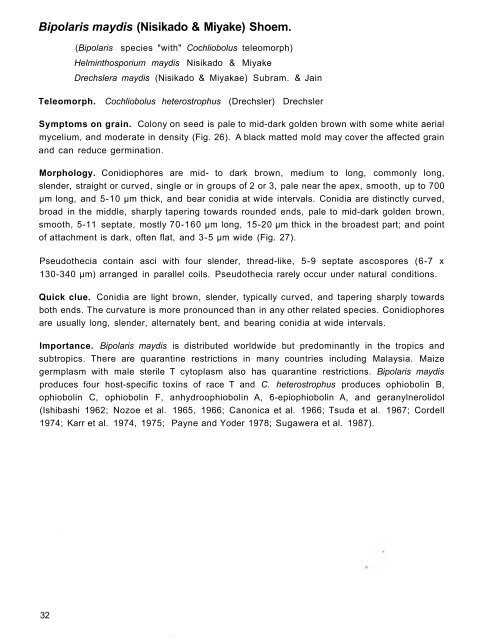A Pictorial Guide for the Identification of Mold ... - OAR@ICRISAT
A Pictorial Guide for the Identification of Mold ... - OAR@ICRISAT
A Pictorial Guide for the Identification of Mold ... - OAR@ICRISAT
Create successful ePaper yourself
Turn your PDF publications into a flip-book with our unique Google optimized e-Paper software.
Bipolaris maydis (Nisikado & Miyake) Shoem.<br />
(Bipolaris species "with" Cochliobolus teleomorph)<br />
Helminthosporium maydis Nisikado & Miyake<br />
Drechslera maydis (Nisikado & Miyakae) Subram. & Jain<br />
Teleomorph. Cochliobolus heterostrophus (Drechsler) Drechsler<br />
Symptoms on grain. Colony on seed is pale to mid-dark golden brown with some white aerial<br />
mycelium, and moderate in density (Fig. 26). A black matted mold may cover <strong>the</strong> affected grain<br />
and can reduce germination.<br />
Morphology. Conidiophores are mid- to dark brown, medium to long, commonly long,<br />
slender, straight or curved, single or in groups <strong>of</strong> 2 or 3, pale near <strong>the</strong> apex, smooth, up to 700<br />
μm long, and 5-10 μm thick, and bear conidia at wide intervals. Conidia are distinctly curved,<br />
broad in <strong>the</strong> middle, sharply tapering towards rounded ends, pale to mid-dark golden brown,<br />
smooth, 5-11 septate, mostly 70-160 μm long, 15-20 μm thick in <strong>the</strong> broadest part; and point<br />
<strong>of</strong> attachment is dark, <strong>of</strong>ten flat, and 3-5 μm wide (Fig. 27).<br />
Pseudo<strong>the</strong>cia contain asci with four slender, thread-like, 5-9 septate ascospores (6-7 x<br />
130-340 μm) arranged in parallel coils. Pseudo<strong>the</strong>cia rarely occur under natural conditions.<br />
Quick clue. Conidia are light brown, slender, typically curved, and tapering sharply towards<br />
both ends. The curvature is more pronounced than in any o<strong>the</strong>r related species. Conidiophores<br />
are usually long, slender, alternately bent, and bearing conidia at wide intervals.<br />
Importance. Bipolaris maydis is distributed worldwide but predominantly in <strong>the</strong> tropics and<br />
subtropics. There are quarantine restrictions in many countries including Malaysia. Maize<br />
germplasm with male sterile T cytoplasm also has quarantine restrictions. Bipolaris maydis<br />
produces four host-specific toxins <strong>of</strong> race T and C. heterostrophus produces ophiobolin B,<br />
ophiobolin C, ophiobolin F, anhydroophiobolin A, 6-epiophiobolin A, and geranylnerolidol<br />
(Ishibashi 1962; Nozoe et al. 1965, 1966; Canonica et al. 1966; Tsuda et al. 1967; Cordell<br />
1974; Karr et al. 1974, 1975; Payne and Yoder 1978; Sugawera et al. 1987).<br />
32
















